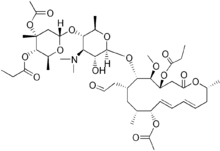 | |
| Clinical data | |
|---|---|
| AHFS/Drugs.com | International Drug Names |
| ATC code | |
| Identifiers | |
| |
| CAS Number | |
| PubChem CID | |
| ChemSpider | |
| UNII | |
| ChEMBL | |
| CompTox Dashboard (EPA) | |
| ECHA InfoCard | 100.054.418 |
| Chemical and physical data | |
| Formula | C45H71NO17 |
| Molar mass | 898.053 g·mol−1 |
| 3D model (JSmol) | |
| Melting point | 220 °C (428 °F) |
| Solubility in water | Slightly soluble in water; Soluble in methanol, acetone and chloroform. mg/mL (20 °C) |
| |
| |
| (verify) | |
Miocamycin is a macrolide antibiotic.[1] It has a spectrum activity similar to that of Erythromycin, but shows higher antimicrobial effect against certain bacteria including Legionella pneumophila (the causative agent of Legionnaires' Disease), Mycoplasma hominis, and Ureaplasma urealyticum.[1] In-vivo studies have further expounded on Miocamycin's efficacy, reporting that the medication is more effective than in-vitro data suggests.[2]
References[edit]
- ^ a b Holliday SM, Faulds D (October 1993). "Miocamycin. A review of its antimicrobial activity, pharmacokinetic properties and therapeutic potential". Drugs. 46 (4): 720–45. doi:10.2165/00003495-199346040-00008. PMID 7506653. S2CID 195692285.
- ^ Lyseng-Williamson, Katherine A (June 2006). "Miocamycin is an effective option in the treatment of various bacterial infections". Drugs & Therapy Perspectives. 22 (6): 1–6. doi:10.2165/00042310-200622060-00001. ISSN 1172-0360. S2CID 72178165.
Well, that’s interesting to know that Psilotum nudum are known as whisk ferns. Psilotum nudum is the commoner species of the two. While the P. flaccidum is a rare species and is found in the tropical islands. Both the species are usually epiphytic in habit and grow upon tree ferns. These species may also be terrestrial and grow in humus or in the crevices of the rocks.
View the detailed Guide of Psilotum nudum: Detailed Study Of Psilotum Nudum (Whisk Fern), Classification, Anatomy, Reproduction